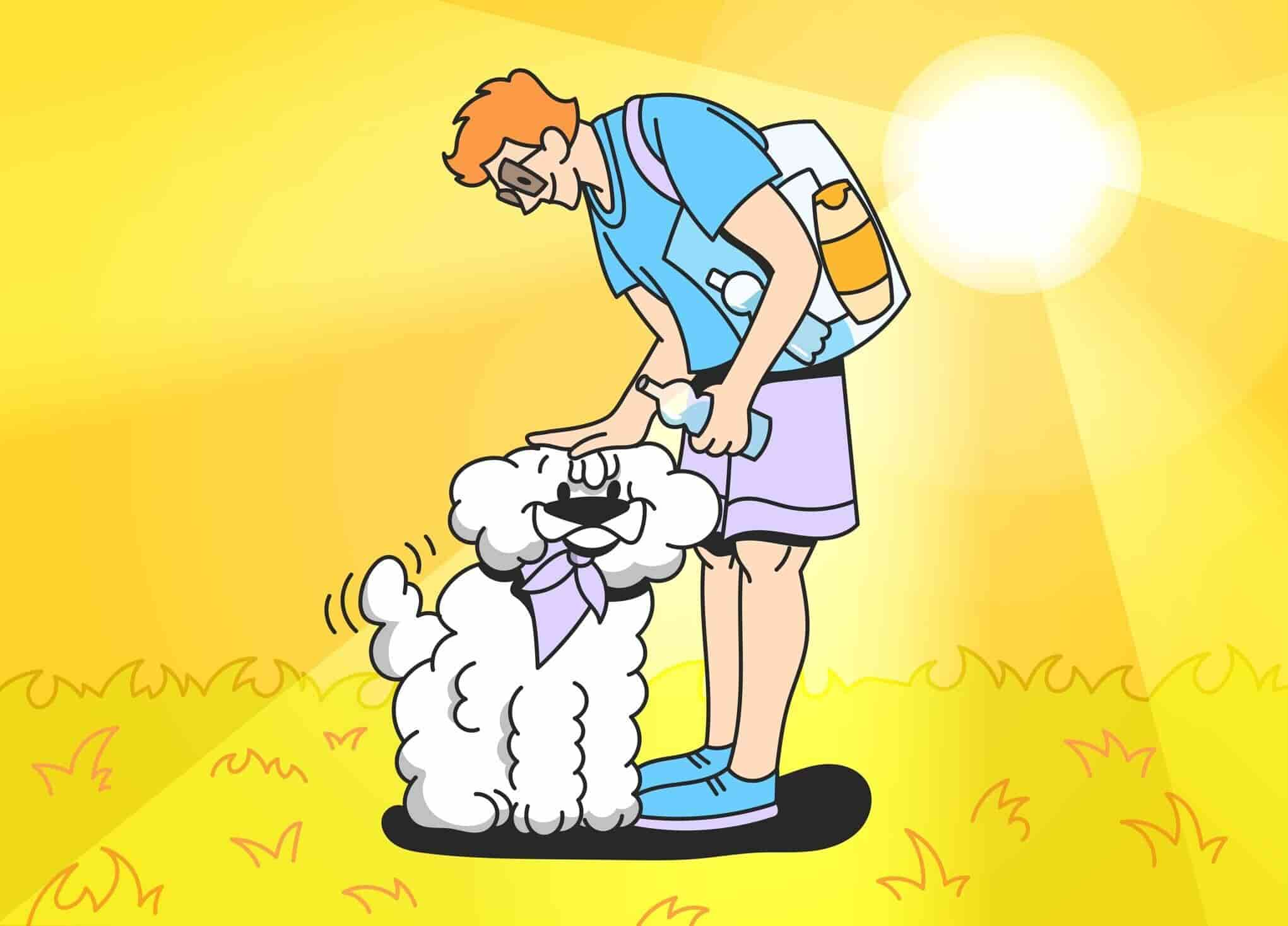
How To Keep Your Pet Safe This Summer
Summertime means sun, beach, and lots of play outdoors with your dog or cat (did you know that adventurous cats are a growing trend?). Summer can be a great time to bond with your pet. But higher temperatures also mean higher risks for our furry companions – more injuries, more skin and ear infections, and a possibility of a heat stroke.
Here is some important information about knowing how to prevent your pet from the most common summer health risks, staying calm about your pet’s health, and no longer following the myths about pet protection during the hot season.
According to our lead Veterinary assistant, Kelly Lepreze and our summer pre-veterinary medicine intern Blayze McCullough, the most common summer risks and preventions for your pet are:
- Parasite Infestation
- Allergies
- Dehydration
- Stroke
- Burns
1. Parasite Prevention Is Best
As the warmer weather of spring and summer brings the outdoors back to life with flowers and animals, the parasites that feed on those animals also make their presence known. Unfortunately, these parasites are numerous and would love to make your pet their new home. Spring and summer means that flea and tick season has arrived, and mosquitoes are also out and about and ready to pass on heartworm disease to dogs and cats. Other parasites, less well known but still important to protect your pets from, include roundworms, hookworms and whipworms.
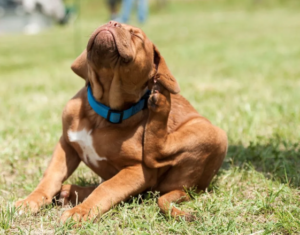
Parasites tend to be unpleasant things, and it may sometimes seem like they are everywhere, just waiting for the opportunity to latch on to our pets. The warmer months of spring, summer and early autumn are the worst for parasites because this is when their hosts are the most available. The good news is that parasites and their ill effects can be combated and treated and in many cases are preventable.
Pay attention if your pet starts to exhibit unusual behavior. Regular screenings can find diseases and parasitic infestation so they can be treated. But as always, it’s better to prevent than to cure. Mitchell Veterinary Clinic recommends regular monthly treatments of Heartgard and NexGard. This prescribed preventative medication will save both you and your animal friend a lot of pain and discomfort.
2. Summer Season Allergies
Dogs can be allergic to numerous different sources, such as pollen, mold, dust, or grass. During the late summer to early fall time we have a significant increase in dogs suffering from red, irritated, and itchy skin. Licking the feet between the toes, scratching ears, or scooting their rear end on the ground can all be signs of seasonal allergies. Allergens can cause this irritation from contact, when a dog walks through the grass, or from inhaling the allergens themselves. Once these allergens have made contact they cause a large release of a substance called histamine that causes the red, itchy, inflamed skin throughout the body.
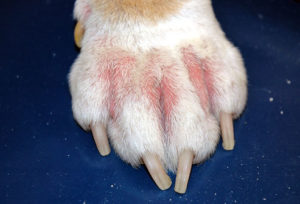
If your pet has been itching and licking his feet or legs for a prolonged period of time, it is possible for them to develop a secondary bacterial infection. Once the skin becomes irritated the natural skin barrier is broken down and bacteria that is normally found on the skin can start to cause an infection. In these cases, you will need to make an appointment with us as soon as possible for antibiotics to help get rid of the bacteria and allow the skin heal.
There are some ways to prevent an initial flare up. With a little bit of effort you can help your pet be comfortable by giving regular baths shampoos and soaps made only for animals and which contain oatmeal. This will help to remove allergens or pollen on your pet’s skin, relieving symptoms and soothing skin.
If a full bath is not possible than a quick wipe down of your pet’s coat, skin, and paws each time they return from outdoors will help remove excess pollen and allergens. Use a moist cloth or hypoallergenic, fragrance-free grooming wipe. This may be especially helpful if your pet’s irritation is localized to their paws. Don’t forget to plump up their diet with omega fatty acids found in many fish oil supplements. These are another way to relieve itchy skin or prevent skin infection. Plus, they’ll help strengthen and soften your pet’s coat.
3. Prevent dehydration by providing plenty of water and shade
We all look forward to longer warmer days. However, long term exposure to Summer weather can be dangerous with out the proper precautions, especially for thicker coated or long hair pets. Our pets do not sweat in the same way humans do and can easily become overheated. Make sure your pet always has access to fresh, clean water inside the house, and bring a bottle for your furry companion when going outside, just like you do for yourself. You might also switch to wet dog food during the hotter months to increase fluid intake.
Dehydration in dogs and cats is a real possibility during the summer. Our dogs get much thirstier than we do when they get hot. Keep your pet in the shade as often as possible. While dogs and cats like to sunbathe, direct sunlight can overheat them (especially dogs) and lead to heat stroke.
Some mild symptoms of dog dehydration include, but aren’t limited to:
- DRY NOSE
A dry nose is an early sign of dehydration, although it can also be a sign of other problems, such as a fever. Dogs with a dry nose should be offered water right away to help combat any other worsening symptoms associated with dehydration, and they should be monitored closely as well.
- EXCESSIVE DROOLING
Dogs who are dehydrated may start to drool excessively. This is because they are trying to cool down their bodies through the best method they have. Excessive drooling is any type of drooling that is not normal for your dog.
- LETHARGY
Dogs who are suffering from even mild dehydration may become lethargic. They may not feel like moving around much and may simply rest until they are able to rehydrate again. If your dog’s dehydration is mild, offer cool, clean water so he can rehydrate on his own time.
- STICKY GUMS
This symptom is on the verge of the moderate stage of dehydration, but it is still generally considered a mild one. If your dog’s gums are sticky, however, watch for signs of worsening dehydration. Not taking quick action for your pet may lead to a serious heat induced stroke.
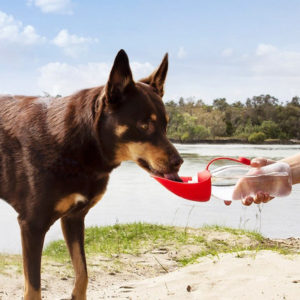
Dr. Bryan recommends that if your pooch is mildly dehydrated give your pet small amounts of water to drink every few minutes or offer your dog pieces of ice to lick. To help restore your dog’s electrolyte balance you could also provide your pet with unflavored Pedialyte or sugar free Gatorade. In small doses, it will help your pet start feeling better quicker.
4. Know The Signs of Heat Stroke
It’s easy for our pets to go from simple dehydration to being overheated in warm muggy weather. Unlike us, they can’t remove layers when it gets hot, and they don’t always have an option to move themselves to cooler places or avoid the sun. Animals are unable to cool down by sweating as humans do, so they are less able to regulate their body temperature. A dog’s normal temperature is between 100° and 103°F, while a normal temperature in cats ranges from 100.4º to 102.5ºF, anything higher than means your pet’s in danger of organ failure or even death. Dogs and cats can both suffer from heatstroke. They drink water and pant to bring down their body temperature.
It doesn’t always have to be ‘hot’ for an animal to develop heatstroke. Exercising excessively in warm weather, or being left in a warm or humid environment that is poorly ventilated can cause animals to quickly overheat. Avoidance is always best, but it’s important to know the signs of heatstroke so that you can treat your pet appropriately and know when to seek veterinary attention should they be unfortunate enough to suffer from it.
Which animals are more susceptible to heatstroke?
- Animals that are overweight
- Flat faced breeds such as Pugs and French Bulldogs, or Persian cats
- Pets with thick coats
- Old or very young animals
- Animals with pre-existing conditions, particularly airway, lung or heart problems
Early signs of heatstroke in pets
These are similar in dogs and cats (although in cats the signs are often more subtle) and can include;
- Panting, this can progress to distressed or noisy breathing as the heatstroke worsens
- Restlessness or agitation, pacing, seeking shade or water
- Drooling
- Red gums or tongue
- Increased heart rate
- Vomiting or diarrhea
Advanced stages of heatstroke in pets
This can include:
- Lethargy
- Confusion
- Weakness or collapse
- Seizures
If your pet shows signs of heat stroke, move them to a cool place, give them a drink of water, put a damp towel over their body, and call the clinic, 417-876-5717, asap. Don’t place your pet in cold water, that can put them into shock.
Tips for preventing heat stroke in dogs and cats
You can help to keep your pet cool and comfortable in summer heat by:
- Making sure your pet always has access to a cool shaded area, both indoors and outside
- Restrict exercise on warm days (dogs should be walked early in the morning or later in the evening to avoid the hottest part of the day)
- Pack a water bottle on walks
- Never leave pets in a car or a hot room
- Ensure your pet always has drinking water available, adding ice can help keep it cool
- Ensure your pet is regularly groomed if this is advised for their breed
5. Pet Burns Are Not Rare
Believe it or not, pets get sunburns too, especially those with short or light hair coats. And just like with people, it hurts and can even lead to skin cancer. If you are planning to spend a day out in the sun with your furry companion, apply sunscreens every 3-4 hours to the least hair-covered spots: bellies, ears, and nose.
Use only sunscreens made specifically for pets. Pets tend to lick it and sunscreen made for humans can include the components that are toxic for animals (like zinc) and this can cause an emergency situation.
Pets heat and cool from the bottom up. If you’re out in the sun together, try to keep your pet off of hot surfaces like cement and asphalt. Remember, hot pavements can burn paws! If it’s too hot to hold your hand on, it’s too hot for your pet to walk on. Not only can it burn paws, but it can also increase body temperature and lead to overheating. It’s also not a good idea to drive around with your dog in the back of a truck – the hot metal can burn paws quickly.
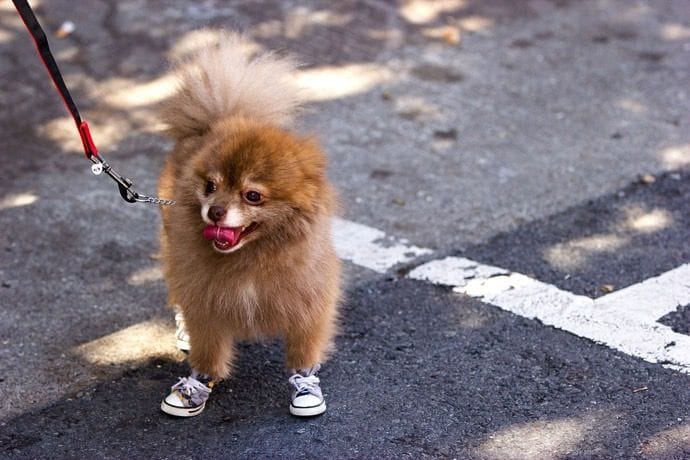
Limiting outdoor activities like walks and playtime to the early morning or late evening can help prevent overheating and burns. If you can’t walk your dog during the early and later hours of the day, doggy boots are a good way to protect their paws.
Keeping all these things in mind will help you to have a safer and more fun Summer!
